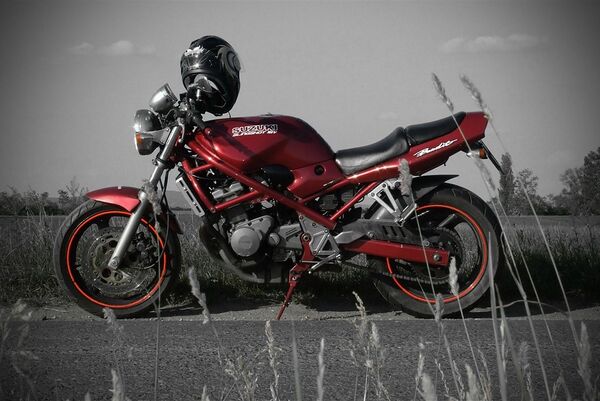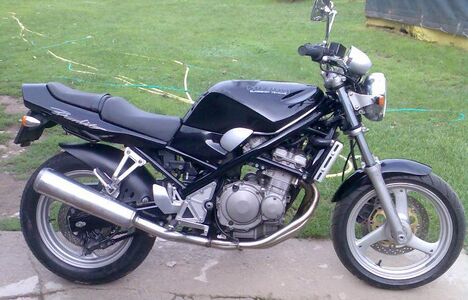Difference between revisions of "Suzuki GSF250 Bandit"
m |
m (→Photos) |
||
| (3 intermediate revisions by the same user not shown) | |||
| Line 1: | Line 1: | ||
{{DISPLAYTITLE: Suzuki GSF 250 Bandit}} | {{DISPLAYTITLE: Suzuki GSF 250 Bandit}} | ||
| + | {{#seo: | ||
| + | |keywords={{PAGENAME}}, review, specs, owners manual, service manual, guide | ||
| + | |og:image=https://en.enduro.team/images/c/c9/NxSMX.jpg | ||
| + | }} | ||
__notoc__ | __notoc__ | ||
| − | [[file: NxSMX.jpg | | + | [[file: NxSMX.jpg | 600px | center | Suzuki GSF250 Bandit]] |
Suzuki GSF 250 Bandit appeared in 1989 along with the older version [[Suzuki_GSF400_Bandit | Suzuki GSF400 Bandit]]. Both models have a lot in common, although they are built on different engines and differ in equipment. For example, the Bandit 250 has undergone the same restyling and updates as the [[Suzuki_GSF400_Bandit | Bandit 400]]. In addition, there were "red-headed" versions of the Suzuki GSF250 Bandit with a variable timing system (VC - variable valve control). | Suzuki GSF 250 Bandit appeared in 1989 along with the older version [[Suzuki_GSF400_Bandit | Suzuki GSF400 Bandit]]. Both models have a lot in common, although they are built on different engines and differ in equipment. For example, the Bandit 250 has undergone the same restyling and updates as the [[Suzuki_GSF400_Bandit | Bandit 400]]. In addition, there were "red-headed" versions of the Suzuki GSF250 Bandit with a variable timing system (VC - variable valve control). | ||
{{Ads_top}} | {{Ads_top}} | ||
| − | |||
| − | |||
| − | |||
| − | |||
| − | |||
| − | |||
| − | |||
| − | + | ''' Lineup: ''' | |
| − | + | * [[Suzuki_GSF250_Bandit | Suzuki GSF250 Bandit]] | |
| − | '' | ||
| − | * | ||
* [[Suzuki_GSF400_Bandit | Suzuki GSF400 Bandit]] | * [[Suzuki_GSF400_Bandit | Suzuki GSF400 Bandit]] | ||
* [[Suzuki_GSF600_Bandit | Suzuki GSF600 Bandit]] | * [[Suzuki_GSF600_Bandit | Suzuki GSF600 Bandit]] | ||
| Line 23: | Line 18: | ||
* [[Suzuki_GSF1250_Bandit | Suzuki GSF1250 Bandit]] | * [[Suzuki_GSF1250_Bandit | Suzuki GSF1250 Bandit]] | ||
| − | '' | + | ''' Main competitors: ''' |
* [[Honda_CB250_Hornet | Honda CB250 Hornet]] | * [[Honda_CB250_Hornet | Honda CB250 Hornet]] | ||
* [[Yamaha_FZX250_Zeal | Yamaha FZX250 Zeal]] | * [[Yamaha_FZX250_Zeal | Yamaha FZX250 Zeal]] | ||
* [[Kawasaki_Balius_250 | Kawasaki Balius 250]] | * [[Kawasaki_Balius_250 | Kawasaki Balius 250]] | ||
| + | |||
| + | Although the Bandit 250 was originally intended only for the domestic Japanese market, in 2000 it was also produced for the Australian market. | ||
| + | |||
| + | The model was based on an in-line 4-cylinder liquid-cooled engine with a volume of 248 cm³, delivering up to 45 hp. power (40 hp - since 1993) and 25 Nm of torque (26 Nm - since 1993). The motor did not become an independent development, but moved from the sports model [[Suzuki_GSX-R250 | Suzuki GSX-R250]]. | ||
| + | |||
| + | In 1995, the Suzuki GSF250 Bandit underwent a restyling with an updated look, an aluminum swingarm, and versions with a VC ("redhead") engine. | ||
| + | |||
| + | 1997 was the last year of production for the Japanese market. In 2000, the model was officially delivered to Australia, but that same year was the final year of production. | ||
| + | |||
| + | Over time, all Japanese motorcycle manufacturers abandoned the concept of small-capacity motorcycles with in-line 4-cylinder engines. Despite the excellent dynamic performance, such models did not have a sufficient engine resource and were quite expensive. As a result, Japanese small-cubic models received simpler (1-2 cylinder), but more resourceful engines and began to have cheaper equipment, which significantly expanded the sales market and made these models available to a wide masses of consumers (including in the role of the first motorcycle). | ||
== Photos == | == Photos == | ||
| − | + | <gallery mode="packed" heights=200px> | |
| − | + | File:2 gsf250 ban.jpg| | |
| − | + | File:760 suzuki-gsf-250-bandit.jpg| | |
| − | + | </gallery> | |
| − | |||
| − | |||
{{Ads_feed}} | {{Ads_feed}} | ||
{{Ads_post}} | {{Ads_post}} | ||
Latest revision as of 19:52, 22 August 2023
Suzuki GSF 250 Bandit appeared in 1989 along with the older version Suzuki GSF400 Bandit. Both models have a lot in common, although they are built on different engines and differ in equipment. For example, the Bandit 250 has undergone the same restyling and updates as the Bandit 400. In addition, there were "red-headed" versions of the Suzuki GSF250 Bandit with a variable timing system (VC - variable valve control).
Lineup:
- Suzuki GSF250 Bandit
- Suzuki GSF400 Bandit
- Suzuki GSF600 Bandit
- Suzuki GSF650 Bandit
- Suzuki GSF750 Bandit
- Suzuki GSF1200 Bandit
- Suzuki GSF1250 Bandit
Main competitors:
Although the Bandit 250 was originally intended only for the domestic Japanese market, in 2000 it was also produced for the Australian market.
The model was based on an in-line 4-cylinder liquid-cooled engine with a volume of 248 cm³, delivering up to 45 hp. power (40 hp - since 1993) and 25 Nm of torque (26 Nm - since 1993). The motor did not become an independent development, but moved from the sports model Suzuki GSX-R250.
In 1995, the Suzuki GSF250 Bandit underwent a restyling with an updated look, an aluminum swingarm, and versions with a VC ("redhead") engine.
1997 was the last year of production for the Japanese market. In 2000, the model was officially delivered to Australia, but that same year was the final year of production.
Over time, all Japanese motorcycle manufacturers abandoned the concept of small-capacity motorcycles with in-line 4-cylinder engines. Despite the excellent dynamic performance, such models did not have a sufficient engine resource and were quite expensive. As a result, Japanese small-cubic models received simpler (1-2 cylinder), but more resourceful engines and began to have cheaper equipment, which significantly expanded the sales market and made these models available to a wide masses of consumers (including in the role of the first motorcycle).
Photos
Specifications
Specifications Suzuki GSF 250 Bandit:
| Model | Suzuki GSF250 Bandit |
|---|---|
| Motorcycle type | road (street, classic) |
| Release year | 1989-1997 (2000) |
| Frame | steel tubular |
| Engine type | 4-cylinder, 4-stroke, in-line |
| Working volume | 248 cm³ |
| Bore / stroke | 49.0 x 33.0 mm |
| Compression ratio | 12.5: 1 |
| Cooling | liquid |
| Number of valves per cylinder | DOHC, 4 valves per cylinder
GSF250V - VC-engine (with variable timing system) |
| Fuel supply system | Carburetor, 4x Mikuni BST29 |
| Ignition type | transistor |
| Maximum power | 45.0 h.p. (33.1 kW) @ 14,500 rpm - GSF250 (1989-1992)
40.0 h.p. (29.4 kW) @ 13,500 rpm - GSF250 (1993-2000) |
| Maximum torque | 25.0 Nm (2.6 kg * m) @ 10,500 rpm - GSF250 (1989-1992)
26.0 Nm (2.7 kg * m) @ 10,000 rpm - GSF250 (1993-2000) |
| Gearbox | 6-speed |
| Drive type | chain |
| Front tire size | 110 / 70R-17M / C 54H |
| Rear tire size | 150 / 70-17M / C 69H - GJ74A
150 / 60R-17M / C 66H - GJ77A |
| Front brakes | 1 disc, 310 mm, 2-piston caliper |
| Rear brakes | 1 disc, 250 mm, 2-piston caliper |
| Front suspension | 41mm Telescopic Fork (Fixed), 120mm Travel |
| Rear suspension | steel swingarm with monoshock (7-stage preload adjustment), travel - 131 mm - GJ74A
aluminum swingarm with monoshock (7-stage preload adjustment), travel - 131 mm - GJ77A |
| Motorcycle length | 2050 mm |
| Motorcycle width | 700 mm - GJ74A
745mm - GJ74A (Classic Handlebar Version) 730 mm - GJ77A |
| Motorcycle height | 1060 mm - GJ74A
1075mm - GJ74A (Classic Handlebar Version) 1055 mm - GJ77A |
| Wheelbase | 1435 mm - GJ74A
1415 mm - GJ77A |
| Saddle height | 750 mm - GJ74A
745 mm - GJ77A |
| Minimum ground clearance | 155 mm - GJ74A
140 mm - GJ77A |
| Acceleration to 100 km / h | 7.0 sec |
| Maximum speed | 180 km / h |
| Fuel tank capacity | 14.0 L - GJ74A
15.0 L - GJ77A |
| Motorcycle weight (dry) | 146 kg - GJ77A |
Documentation


